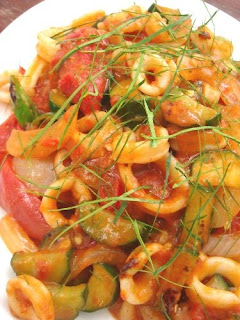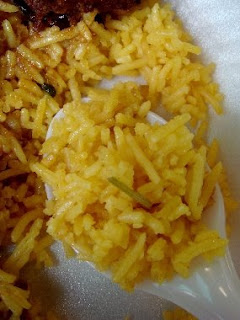

私はシンガポール(SG)料理が大好きだ。しかし、全ての品目が旨いとは思っていない。ローカルの人が絶賛していても、時に、私には理解不能なものがある。食べ物は嗜好品な訳だから、当然といえば当然。しかし、料理に関していえば仕事上、出来るだけ客観的に味わう事にしている。どうして、この料理・逸品が旨いとされているのか?そのロジックを考えるようにしている。直感的に旨いと感じる主観的な感覚とは全く逆に考えるようにしている。例えば、5年前はその味の良さがわからなかったものも、今では本当に好きになっている料理も少なくない。何度もシンガポールへ訪れる度に、その料理に再チャレンジし、諦めずに舌&脳がその料理を魂から受け入れて、ソウルフード(soul food)と実感出来るようにと常に頑張っています。この「味の良さがわからないSG料理」はシリーズ化いたします。
その料理の一つがミーレブス(mee rebus / 马来卤面)。マレー語で直訳すると、mee=麺・rebus=茹でるすなわち、茹でた麺という事になる。このミーレブス、どのような料理かというと、茹でた卵麺を甘いダークソイソース・タマリンド・マッシュしたサツマイモで作ったクレービーと和えて、ゆで卵・グリーンチリ・小さく切った厚揚豆腐をトッピングした、すごくシンプルな料理である。甘ったるいので、ライムを搾って食べる。確かに、文章の説明からするとどうもぼやけた料理という印象を受けるが、ミーレブスはシンガポール観光局(
STB)が旅行者向けに発行しているマカン・デライト(Makan Delights)のリストに掲載されている。すなわち、れっきとした、数多くあるシンガポール料理の中の代表と言える逸品なのである。ちなみに、この料理はマレー系だが、チャイニーズの影響も受けている‐卵麺・ソイソース・厚揚。さて、このシンプルな料理の良さについて考えてみたい。そもそも、シンプルが基本の和に通ずるものがあるかもしれない。例えば、もり蕎麦や掛蕎麦はシンプルの極みだがその旨さについて語れば、きりが無い。ミーレブスにもそれがあるかもしれない。地元の人がどのように絶賛をしているのか、ネットで調べてみたが、残念ながらピンポイントで「旨そうだな」というサイトは無い。しかし、ちょっとよさそうな表現をするサイトを発見した
(aroma cookery)→「ミーレブスの旨さはそのグレービーにある。色んな食材が実は使われている:ガランガル(galangal / カー)・エシャロット・にんにく・赤唐辛子・ターメリック・ブラチャン。そして、そのペーストをじっくり鍋で煮込み、牛骨スープとエビガラの出しで伸ばし、サツマイモのピューレを混ぜ込む。」
なるほど、これは旨そうなグレービーだ。この基本を大事に、もっと旨いミーレブスが出来るのではないか、今度試作品にチャレンジしたいと思う。To be continued....
I must confess, Singaporean food is my soul food (outside Japanese food that is), but some of the dishes are not as lip-smacking as chicken rice, bak kut teh, hokkien mee, etc. I guess in order to appreciate these kinds of (I call them) secondary flavourful dishes (as opposed to chicken rice, satay, etc.), one needs to understand the true standards of these dishes. Of course this takes time and one such dish is: mee rebus -a Malay dish with Chinese influence. What is the standard of a perfect mee rebus? Now, the dish is composed of perfectly blanched egg noodles with gravy made from sweet potato and mire poix, topped with boiled egg, fried shallots, chopped green chillies, brunoise of deep fried tofu (tau pok), garnished with kalamansi lime to cut the sweetness of the gravy. What makes this dish to die for? Die die must try how? First of all, and I don't think I am alone in this, it is overly sweet and you need more acid to cut that sweetness. Therefore, first bite is usually semi-satisfying but as you go on, you get tired of that sweet and bland taste. But I wonder why this is. I absolutely adore sukiyaki but sukiyaki is sweet too. Let me think... I guess the wagyu beef's fatty richness goes very well with the sweetness of warishita (sukiyaki sauce), just like sauteed foie gras with figs and port wine reduction, or just like Hokkienese braised pork belly's (紅焼扣肉) fatty richness is complemented with sweet dark soy sauce braise. In mee rebus' case, the sweetness of the gravy is prevalent but the richness doesn't seem to take play. The garnishes are very basic, and you don't know what the key garnish, namely what is the main garnish? HKM and BCM have much clearer focus in terms of garnish. Someone, please tell me the true standards of mee rebus.

 ミーシアム(Mee Siam / 米暹)はサイアムと書くが、実はシアムと読む。サイアムというだけに、タイの影響がありそうな麺だが、これそのものはタイには存在しないのではないか?タイにもよく行く事があるが、まったく見かけた事がない。仮説だが、この逸品そのものが、甘酸っぱいグレービーで出来ている事から名付けられたのではないかと考える。甘酸っぱいという味覚はタイでは当り前の為・・・酸味はタマリンドとカラマンスィライム、そして甘味は砂糖から来ている。味付けには主にタオチオ(味噌のような調味料)、乾燥エビ、ブラチャンを使用。時には、ココナッツミルクが入る場合がある(ペラナカン料理の場合・写真上)。トッピングには厚揚げ、モヤシ、ネギ、ゆで卵。「ミー」なのだが、本来卵麺にミーをつけるが、この料理は見ての通り、ビーフンを使用。この料理、前回、味の良さがわからないミーレブスと似ている。ソースがとにかく甘ったるく、ぼやけた味に仕上がっている。酸味が加わっているのだが、あまりインパクトが無い。ちなみにこのミーシアムもシンガポールを代表する料理の一つだ。シンガポール政府観光局の発行しているMakan Delightsにも掲載されている。この美味さを何時の日か、是非とも理解したいと願っている。
ミーシアム(Mee Siam / 米暹)はサイアムと書くが、実はシアムと読む。サイアムというだけに、タイの影響がありそうな麺だが、これそのものはタイには存在しないのではないか?タイにもよく行く事があるが、まったく見かけた事がない。仮説だが、この逸品そのものが、甘酸っぱいグレービーで出来ている事から名付けられたのではないかと考える。甘酸っぱいという味覚はタイでは当り前の為・・・酸味はタマリンドとカラマンスィライム、そして甘味は砂糖から来ている。味付けには主にタオチオ(味噌のような調味料)、乾燥エビ、ブラチャンを使用。時には、ココナッツミルクが入る場合がある(ペラナカン料理の場合・写真上)。トッピングには厚揚げ、モヤシ、ネギ、ゆで卵。「ミー」なのだが、本来卵麺にミーをつけるが、この料理は見ての通り、ビーフンを使用。この料理、前回、味の良さがわからないミーレブスと似ている。ソースがとにかく甘ったるく、ぼやけた味に仕上がっている。酸味が加わっているのだが、あまりインパクトが無い。ちなみにこのミーシアムもシンガポールを代表する料理の一つだ。シンガポール政府観光局の発行しているMakan Delightsにも掲載されている。この美味さを何時の日か、是非とも理解したいと願っている。

























 ノーサインボード
ノーサインボード





















